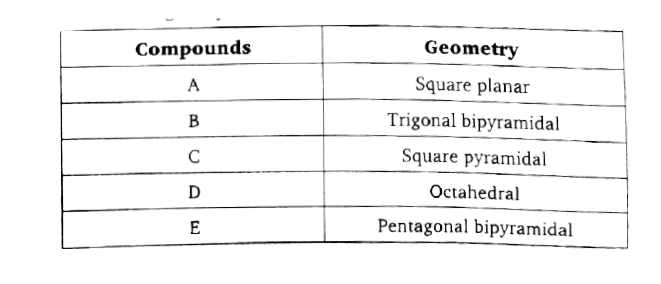If x and y are total number of electrons which are present in non-axial and axial set off d-orbitals respectively in Ni cation of [Ni(DMG)2], then calculate the value of 2x2y
The correct Answer is:36
To solve the problem, we need to determine the values of x and y for the coordination compound (Ni(DMG)2) and then calculate the expression 2x2y.
1. Identify the Oxidation State of Nickel:
- The ligand DMG (dimethylglyoxime) has a charge of -1 and there are two DMG ligands in the complex.
- Let the oxidation state of Ni be x.
- The overall charge of the complex is neutral (0).
- Therefore, the equation is:
x+2(−1)=0⟹x−2=0⟹x=+2
- Thus, the oxidation state of Nickel in (Ni(DMG)2) is +2.
2. Determine the Electron Configuration of Ni²⁺:
- The atomic number of Nickel (Ni) is 28.
- The ground state electron configuration of Ni is:
(Ar)4s23d8
- For Ni²⁺, we remove two electrons from the 4s orbital:
Ni2+:(Ar)3d8
3. Distribute the Electrons in d-Orbitals:
- The 3d orbitals can be represented as follows:
- dxy,dyz,dzx (non-axial orbitals)
- dx2−y2,dz2 (axial orbitals)
- The distribution of 8 electrons in the 3d orbitals is:
- Non-axial (3 orbitals): dxy,dyz,dzx can hold 6 electrons (2 in each).
- Axial (2 orbitals): dx2−y2,dz2 can hold 2 electrons (1 in each).
4. Calculate x and y:
- x (total number of electrons in non-axial orbitals):
x=6(2 in dxy+2 in dyz+2 in dzx)
- y (total number of electrons in axial orbitals):
y=2(1 in dx2−y2+1 in dz2)
5. Substitute x and y into the Expression:
- We need to calculate:
2x2y
- Substitute x=6 and y=2:
2(6)22=2×362=36
Final Answer:
The value of 2x2y is 36.
- The ligand DMG (dimethylglyoxime) has a charge of -1 and there are two DMG ligands in the complex.
- Let the oxidation state of Ni be x.
- The overall charge of the complex is neutral (0).
- Therefore, the equation is:
x+2(−1)=0⟹x−2=0⟹x=+2
- Thus, the oxidation state of Nickel in (Ni(DMG)2) is +2.
- The atomic number of Nickel (Ni) is 28.
- The ground state electron configuration of Ni is:
(Ar)4s23d8
- For Ni²⁺, we remove two electrons from the 4s orbital:
Ni2+:(Ar)3d8
- The 3d orbitals can be represented as follows:
- dxy,dyz,dzx (non-axial orbitals)
- dx2−y2,dz2 (axial orbitals)
- The distribution of 8 electrons in the 3d orbitals is:
- Non-axial (3 orbitals): dxy,dyz,dzx can hold 6 electrons (2 in each).
- Axial (2 orbitals): dx2−y2,dz2 can hold 2 electrons (1 in each).
- x (total number of electrons in non-axial orbitals):
x=6(2 in dxy+2 in dyz+2 in dzx)
- y (total number of electrons in axial orbitals):
y=2(1 in dx2−y2+1 in dz2)
- We need to calculate:
2x2y
- Substitute x=6 and y=2:
2(6)22=2×362=36
The value of 2x2y is 36.
Topper's Solved these Questions
- CO-ORDINATION COMPOUNDSBOOK - VK JAISWAL ENGLISHCHAPTER - CO-ORDINATION COMPOUNDSEXERCISE - LEVEL 2
144 Videos
- CO-ORDINATION COMPOUNDSBOOK - VK JAISWAL ENGLISHCHAPTER - CO-ORDINATION COMPOUNDSEXERCISE - ASSERTION-REASON TYPE QUESTIONS
26 Videos
- CHEMICAL BONDING (BASIC)BOOK - VK JAISWAL ENGLISHCHAPTER - CHEMICAL BONDING (BASIC)EXERCISE - SUBJECTIVE PROBLEMS
54 Videos
- d-BLOCK ELEMENTSBOOK - VK JAISWAL ENGLISHCHAPTER - d-BLOCK ELEMENTSEXERCISE - ASSERTION-REASON TYPE QUESTIONS
32 Videos
Similar Questions
Calculate the total number of electrons present in 3.2g of oxygen gas.
View SolutionState the number of unpaired electrons in Ni2+ :
View SolutionThe total number of electrons present in all s orbitals, all the p orbitals, and all the d orbitals of cesium ion are, respectively,
View SolutionThe number of unpaired electron in Ni2+ is
View SolutionHow many electrons are present in dz2 orbital of [Ni(gly)2] ? .
View SolutionHow many electrons are present in t2g set of d-orbitals of central metal cation in [Fe(H2O)5(NO)]SO4 brown ring complex?
View SolutionConsider the following compounds with their regular geometries.

Calculate value of (x+y−z)2, where x is total number of axial d-orbitals having zero nodal plane, y and z are total no. of non-axial and axial d-orbitals respectively each one having two nodal planes used in hybridisation of central atoms of compounds A to E.
View SolutionConsider the following compounds with their regular geometries.

Calculate value of (x+y−z)2, where x is total number of axial d-orbitals having zero nodal plane, y and z are total no. of non-axial and axial d-orbitals respectively each one having two nodal planes used in hybridisation of central atoms of compounds A to E.
View SolutionHow many unpaired electrons are present in Ni2+ cation? (At. No. = 28)
View SolutionThe maximum number of electrons that can be accomoddated in dx2−y2 orbital is
View Solution
